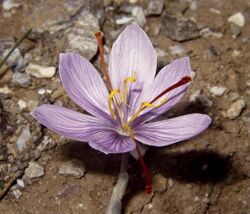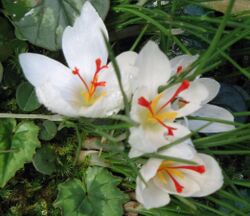Biology:Crocus cartwrightianus
| Crocus cartwrightianus | |
|---|---|

| |
| Scientific classification | |
| Kingdom: | Plantae |
| Clade: | Tracheophytes |
| Clade: | Angiosperms |
| Clade: | Monocots |
| Order: | Asparagales |
| Family: | Iridaceae |
| Genus: | Crocus |
| Species: | C. cartwrightianus
|
| Binomial name | |
| Crocus cartwrightianus Herb.
| |
Crocus cartwrightianus is a species of flowering plant in the family Iridaceae, native to mainland Greece and Crete. It is a cormous perennial growing to 5 cm (2 in). The flowers, in shades of lilac or white with purple veins and prominent red stigmas, appear with the leaves in autumn and winter.[1]
Description
The flower style divides while still within the throat of the flower, well below the bases of the anthers. The branches of the stigma are taller than the anthers and about the same length as the petals. The throat of the flower is bearded. The leaves and flowers are produced at the same.[2][clarification needed]
The Latin specific epithet cartwrightianus refers to the 19th century British Consul to Constantinople, John Cartwright.[3]
C. cartwrightianus is the presumed wild progenitor of the domesticated triploid Crocus sativus – the saffron crocus.[4][5][6] Although some doubts remain on its origin,[7] it is believed that saffron originated in Iran.[8] However, Greece[7] and Mesopotamia[8] have also been suggested as the possible region of origin of this plant.
Habitat
This species is commonly found growing on limestone soil areas of the Attica Peninsula of Greece.
Cultivation
There is evidence that this plant was cultivated in ancient Crete at least as early as the Middle Minoan Period, as exhibited by a mural, the "Saffron Gatherer", illustrating the gathering of crocuses.[9]
This plant,[10] has gained the Royal Horticultural Society's Award of Garden Merit.
References
- ↑ RHS A-Z encyclopedia of garden plants. United Kingdom: Dorling Kindersley. 2008. pp. 1136. ISBN 978-1405332965.
- ↑ Feinbrun, Naomi (1957). "The Genus Crocus in Israel and Neighbouring Countries". Kew Bulletin 12 (2): 269–285. doi:10.2307/4114421. ISSN 0075-5974. https://www.jstor.org/stable/4114421.
- ↑ Harrison, Lorraine (2012). RHS Latin for gardeners. United Kingdom: Mitchell Beazley. pp. 224. ISBN 9781845337315.
- ↑ M. Grilli Caiola - Saffron reproductive biology
- ↑ Nemati, Zahra; Blattner, Frank R.; Kerndorff, Helmut; Erol, Osman; Harpke, Dörte (2018-10-01). "Phylogeny of the saffron-crocus species group, Crocus series Crocus (Iridaceae)". Molecular Phylogenetics and Evolution 127: 891–897. doi:10.1016/j.ympev.2018.06.036. ISSN 1055-7903. PMID 29936028.
- ↑ Schmidt, Thomas; Heitkam, Tony; Liedtke, Susan; Schubert, Veit; Menzel, Gerhard (2019). "Adding color to a century-old enigma: multi-color chromosome identification unravels the autotriploid nature of saffron (Crocus sativus) as a hybrid of wild Crocus cartwrightianus cytotypes" (in en). New Phytologist 222 (4): 1965–1980. doi:10.1111/nph.15715. ISSN 1469-8137. PMID 30690735.
- ↑ 7.0 7.1 Gresta, F.; Lombardo, G. M.; Siracusa, L.; Ruberto, G. (2008). "Saffron, an alternative crop for sustainable agricultural systems. A review". Agronomy for Sustainable Development 28 (1): 95–112. doi:10.1051/agro:2007030. https://hal.archives-ouvertes.fr/hal-00886393/document.
- ↑ 8.0 8.1 Ghorbani, R.; Koocheki, A. (2017). "Sustainable Cultivation of Saffron in Iran". in Lichtfouse, Eric. Sustainable Agriculture Reviews. Springer. pp. 170–171. doi:10.1007/978-3-319-58679-3. ISBN 978-3-319-58679-3. https://books.google.com/books?id=cdksDwAAQBAJ&pg=PA170.
- ↑ C.Michael Hogan, Knossos Fieldnotes, the Modern Antiquarian (2007)
- ↑ "RHS Plant Selector - Crocus cartwrightianus". https://www.rhs.org.uk/Plants/4868/Crocus-cartwrightianus/Details.
External links
- {{citation
| mode = cs1 | title = Crocus cartwrightianus | work = Germplasm Resources Information Network (GRIN) | url = | publisher = [[Organization:Agricultural Research ServAgricultural Research Service (ARS), United States Department of Agriculture (USDA) | access-date = }}
Wikidata ☰ Q291315 entry
 |


